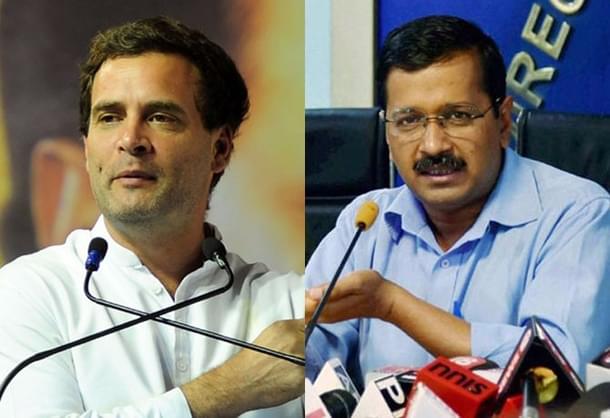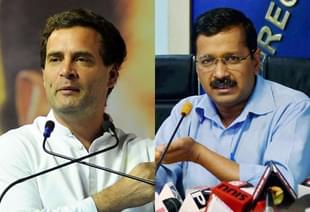Politics
Delhi Polls Takeout: AAP, Congress Battling For Same Opposition Space; Rahul-Kejriwal Are Thus Good For BJP
R Jagannathan
Apr 26, 2017, 10:32 AM | Updated 10:32 AM IST
Save & read from anywhere!
Bookmark stories for easy access on any device or the Swarajya app.


The big news from Delhi is not the Bharatiya Janata Party (BJP) win in the three Delhi municipal corporations (North, East and South), but the marginally better-than-expected performance of both the Congress and the Aam Aadmi Party (AAP). The exit polls showed the BJP winning more than 200 seats out of the 270 that went to the polls. The final results may show the BJP falling well short of that.
However, this should not disappoint the BJP for the election establishes one thing: the real fight is for the anti-BJP space among opposition parties. As long as this remains true, the BJP will be sitting pretty and let the rest fight for No 2 and No 3 spots.
The BJP should thus chill and focus on its message and work. This hasn’t been the case since 2013, and particularly after the 2015 drubbing it received at the hands of AAP in the Delhi assembly elections. Modi’s party has been excessively spooked by Arvind Kejriwal and his unconventional politics of shoot-and-scoot, where he targeted Narendra Modi and the BJP directly without providing proof. The BJP feared that Kejriwal had the potential to rise as a national figure to challenge Modi.
This was never going to happen for the simple reason that both AAP and Congress were fighting for the same space – and the Municipal Corporation of Delhi (MCD) results prove exactly that. At the time of writing around 10am on Wednesday (26 April), Congress and AAP were more or less heading towards a near-equal share of seats.
In hindsight, this should have been obvious, as this writer has been saying repeatedly. The BJP has unique positioning as a Hindu party, which the others do not. While the Hindu vote may split this way or that, driven by caste or other considerations, the voter knows what it stands for.
On the other hand, the so-called “secular” parties depend on proving themselves to be more pro-minority than the other. They depend on Muslims voting en bloc in their favour, with the Hindu vote dividing itself based on other considerations. Unfortunately for the “secular” parties, the Hindu vote has not been neatly dividing itself up in most recent elections, thanks to Modi’s overwhelming image and the perceived appeasement of minorities by the rest. Minoritarian parties cannot challenge the BJP.
More importantly, Modi has neatly shifted the BJP to the centre-left rather than remaining centre-right. He has espoused pro-poor policies ever since he became Prime Minister in May 2014. This has put the BJP bang in the middle of the political spectrum, forcing the opposition parties to choose between more self-defeating left-wing rhetoric (for which there is no bulk vote) or (the even less appealing) pro-market space.
Modi’s genius has been to be overtly pro-poor without actually becoming anti-business.
Logically, this should have been the positioning of Kejriwal and the Congress, but the former took on shrill anti-business rhetoric and the latter has not been able to extricate itself from the growth-destructive policies of UPA-2. With Modi taking the high moral ground on black money, it leaves Congress and regional parties stuck with the label of being corrupt by default.
Kejriwal’s original calling card was his high morality, including his anti-corruption jihad. But after becoming Chief Minister of Delhi, his focus shifted to expanding the AAP footprint across India, and not delivering on his promises in Delhi. But as of now, it is Modi – despite doing nothing to make the Lok Pal a reality – who is looking like cleaning up politics.
Kejriwal’s other personal calling card was a degree of idealism. But it is Modi who is looking like a hopeless idealist – with his Swachch Bharat campaign, demonetisation of high value notes, and promises to doubling farm incomes and providing homes for all. More importantly, Modi seems to be actually working towards his goals, even if he finally falls short in achievement. That combination, of perceived idealism backed by hard work, is hard to beat. People give Modi full marks for efforts, even if the results may be less wholesome.
The final takeaways:
Modi can be defeated only when the opposition combines, as in Bihar.
The opposition will not find this easy, as one party’s gain will come only at the expense of the other – as the Delhi sharing of honours between AAP and Congress shows. In Uttar Pradesh, the Bahujan Samaj Party, Samajwadi Party and Congress will have to shrink their ambitions to take on the BJP. And elsewhere too.
Kejriwal’s holier-than-thou politics cannot work. Indians know that their leaders are corrupt, the difference being only one of degree. At the end of the day, they want visible benefits not promises. In this, Modi looks more likely to deliver than a congenital accusation-thrower like Kejriwal.
If Kejriwal wants to revive his party’s fortunes by 2019 or 2020 (when assembly elections are due), he has to focus on his job as Delhi Chief Minister, and not constantly seek to remain in the limelight by making wild allegations against his political opponents. Even more important, the label of being pro-change is now looking more plausible on the lapels of Yogendra Yadav’s Swaraj Abhiyan, the very man he threw out in a power struggle. If Kejriwal wants to return to favour, he should consider merging the two parties, and reduce his role in the party. He should either be CM or the party chief, not both.
Delhi proves one more thing: just as an inept Rahul Gandhi has proved to be the BJP’s best guarantor of primacy in national politics, Kejriwal now bids fair to become the BJP’s second trump card. So, far from calling for Kejriwal’s resignation after the Delhi defeat, the BJP should be praying he stays in the job, and continues as before.
Ideologically, Modi has stolen the Congress’ centre-left clothes, and spiced it up with subtle nationalistic and majoritarian rhetoric. The BJP’s social engineering has also been more sensible – and seems to be holding. Its only weakness is its ability to alienate the minorities and Dalits by mindlessly giving space to assorted gau rakshaks with a penchant for violence.
In 2019, the BJP will probably make overtures to the lower end of the Muslim class structure (the Pasmandas) and women (through strident backing for a ban on triple talaq), which means the possibility of a split in the minority vote cannot be ruled out, even if it is only a small split. In Gujarat, the Muslim vote started swinging away from Congress once Modi established himself as the supreme power in the state. Muslims may have no love lost for the BJP right now, but they will see some value in doing a deal with the only man who has the power to deliver something to them. The minoritarian parties cannot deliver either jobs or protection to Muslims. Perhaps Modi can.
Jagannathan is former Editorial Director, Swarajya. He tweets at @TheJaggi.





